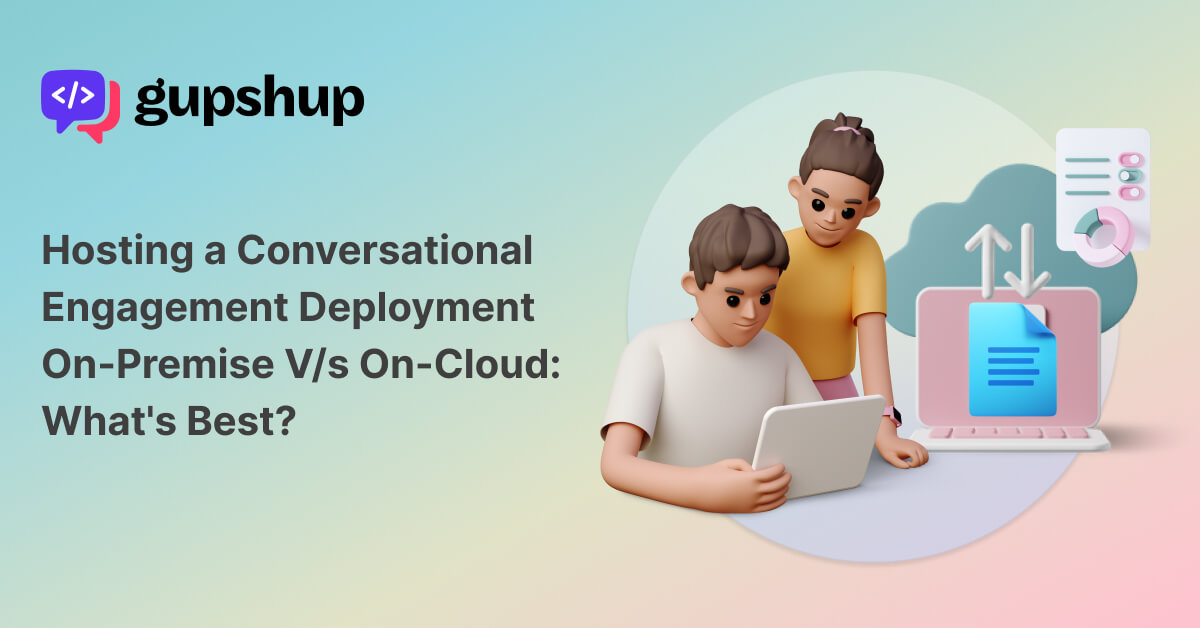Hosting a Conversational Engagement Deployment On-Premise V/s On-Cloud: What’s Best?

As we spearhead into a decade marked by astonishing digital transformations, one aspect looms large: Conversational Engagement.
Gartner predicts that by 2027, emerging technologies such as AI chatbots and Virtual Customer Assistance will take over nearly 25% of organizations as their primary source of customer service channels.
With brands forging deeper, more intricate relationships with their customers through digital dialogues, a quintessential question arises: Where should this interaction be hosted – On-Premise or in the Cloud?
By making an informed choice between On Premise vs Cloud, businesses can not only drive customer engagement but also determine their operational efficiency, agility, and innovation trajectory. As the stakes get higher, the debate between On-Premise vs. Cloud becomes not just about technological preference but about sculpting a brand’s digital destiny.
Understanding the Contenders
What is On-Premise Deployment?
An On-Premise deployment can be visualized as a family heirloom, a treasure trove safeguarded within the bounds of your property. It implies hosting applications and data storage on an organization’s internal infrastructure, shielded behind its walls.

A survey run by O’Reilly documented that almost 55% of respondents still operated their businesses On-Premise- this could be attributed mainly to the worries about security and control. With these setups, companies feel they have a tighter hold on their data, from how it’s stored to who can access it, ensuring they stick to compliance rules.
Given the tangible nature of On-Premise setups, businesses enjoy the privilege of customizing their infrastructure, tailoring it meticulously to their needs, and ensuring that every nook and corner serves a definitive purpose.
What is Cloud Deployment?
The realm of Cloud deployment is akin to leasing a penthouse in a soaring skyscraper. Your applications and database are in the luxury of third-party servers. You’re bestowed with world-class amenities and can scale up or down based on your needs without the baggage of maintenance or long-term anchoring.
A report by Gartner forecasts that by 2025, over 95% of digital workload will be deployed leveraging Cloud-native approaches, testifying to the growing trust and reliance businesses have in Cloud capacities. Additionally, the Cloud computing market pegged at $371.4 billion in 2020, is predicted to grow to $832.1 billion by 2025, according to MarketsandMarkets.
The Cloud offers unprecedented agility, allowing businesses to pivot as per market dynamics. Need more storage or computational power for a mega-sale event? Cloud platforms can provision resources in real-time, ensuring that businesses stay agile and customer experiences remain seamless.
Diving Deep: On-Premise vs. Cloud Showdown
The arena is set; the gloves are off. As we examine the duel between SaaS vs On-Premise deployment, it’s critical to focus on four main contenders in the ring: Financial Considerations, Scalability, Security, and Data Gravity.
Let’s dissect each category for a more informed decision.
1. The Financial Footprint: Budgeting for the Long Haul
- On-Premise: Investing in an On-Premise solution is akin to building a grand mansion. The upfront capital expenditure is high, involving hardware, software licenses, and infrastructure setup. However, the long-term operational costs can be lower without subscription fees. Economic sustainability depends on how efficiently you manage your internal resources.
- Cloud: Renting a luxury apartment is the metaphor here. You have low initial costs, but as your data and computational needs grow, so do your monthly subscriptions. Furthermore, charges might be associated with increased bandwidth, additional storage, or specialized services and products. Cloud services predominantly operate using a pay-as-you-go approach, providing users with economic adaptability, yet expenses often accrue progressively.
2. Scaling Skies or Grounded Growth: Elasticity vs Control
- On-Premise: You’re in complete control of the entire architecture, but every change—be it adding storage or increasing processing power—requires meticulous planning. Resources need to be ordered, installed, and configured, which could disrupt business operations. So, while you have complete control, the scalability is somewhat rigid.
- Cloud: The Cloud is more like a modular home that adapts to your needs. As your business requirements fluctuate, you can quickly scale up or down without the logistical nightmares of hardware procurement. The service provider handles most of the heavy lifting, allowing you to focus on your business.
3. Safeguarding Secrets: The Security Showdown
- On-Premise: Driving your own car offers a sense of control, but you’re also responsible for its maintenance and security. While On-Premise deployments offer enhanced control over your data, security, compliance, and backups are on your organization’s shoulders.
- Cloud: Consider it as entrusting your prized possessions to a high-security bank. While they provide advanced safeguards like encryption and multi-factor authentication, there’s an underlying apprehension: you’re not the sole key-holder. Issues of data residency and third-party access might occasionally cast shadows on your peace of mind.
4. Gravitate Towards Data: Where Does Your Data Reside?
- On-Premise: If most of your critical data resides in-house, an On-Premise solution will reduce the latency and costs associated with data transfer, offering seamless operations.
- Cloud: For organizations that rely on multiple third-party services, databases, and collaboration tools, the Cloud acts as a centralized hub, enabling efficient data management and operations.
The Choice Matters!
The global conversational AI market size was valued at USD 10.7 billion in 2022 and is projected to grow to USD 29.8 billion by 2028 at a compound annual growth rate (CAGR) of 21.9%. With such rapid growth, where you choose to deploy can greatly influence your brand’s agility, cost-efficiency, and innovation potential in harnessing conversational AI’s potential.
A Comparative Analysis: Difference Between On Premise and Cloud

These distinctions offer a more rounded view of the pros and cons associated with each deployment model. Both On-Premise and Cloud have their strengths and weaknesses, and in the intricate dance of On-Premise vs Cloud, there’s no universal victor, only what aligns best with your brand’s vision, strategy, and operational nuances.
Choose wisely, and let every conversation shine.
Gupshup: Pioneering the Future of Conversations
No matter where you stand in the On-Premise vs Cloud debate, the endgame remains constant: fostering compelling, effective conversations.
Enter Gupshup.io.
Steering over 10 billion conversations monthly, Gupshup emerges as a titan of conversational sophistication. Entrusted by industry titans like Netflix, Citibank, and Flipkart, Gupshup’s AI-powered solutions ensure brands take conversational engagement to the next level.
Isn’t it time you championed world-class conversational experiences?
Connect with Gupshup, and let’s sculpt the future, one conversation at a time!




